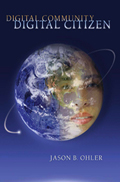Recently I had the pleasure of helping to design a critical thinking course for Fielding Graduate University’s Ph.D. program in Media Psychology. It is the first course that students take as they enter the program, and is actually a half course that happens quickly over ten weeks in a kind of compressed time. During that 10 weeks students need to begin developing the critical thinking skills and structured suspicion necessary to peel back the layers of the media onion in order to begin to understand the nature of media bias and persuasion.
In this course, critical thinking roughly equates to media literacy. There are two periods of modern media literacy, each of which corresponds to plateaus in technology. They are described below.
Media Literacy 1.0 - the era of mass media
In a sentence, Media Literacy 1.0 concerns the ability to identify and evaluate the techniques of media persuasion. It arose during the era of one-to-many mass media (radio, TV, print) in response to the concern that media companies and advertisers were trying to persuade us to think in certain ways and buy specific products. We were a captive audience with no way to talk back to the media that was talking to us. The emphasis in ML 1.0 was on protecting ourselves as media consumers.
Media Literacy 2.0 - the era of digital participation
In a sentence, Media Literacy 2.0 concerns the ability to identify, evaluate and apply the techniques of media persuasion. Note the addition of the word “apply.”
All of the earlier concerns of Media Literacy 1.0 are still in play, but now we expect students to “write effective media.” Media 2.0 began sometime during the past ten years, during which hardware and software became inexpensive and the web became universal, allowing anyone to create a news blog, radio station or TV channel.
Writing media helps us to read it
There is no better way to understand media persuasion than to create media. It allows students to lift the hood, so to speak, and see the internal workings of media production that conspire to do one thing above all others: make media appear effortless, harmless and natural. (The application aspect of media literacy is addressed in other courses within the Ph.D. program.)
Feel free to mine the course for resources
If you are interested in how this course views critical thinking, you are welcome to mine the course for ideas and resources. Just go to the course site and look around. Pay particular attention to the weekly topics on the right hand side, which include urban legends, musical persuasion, manipulation through word smithing, consumer psychology, media gate keeping and the impact of social media.
Effectively, creatively, wisely
The goal is always to have students use technology effectively, creatively and wisely. Becoming media literate demands all three.
Wednesday, April 8, 2009
Subscribe to:
Post Comments (Atom)







1 comment:
I liked your ideas about thinking and suspicion in relation to the layers of the media onion. I have always thought that my job as a teacher was to help students become good thinkers and readers. If those two items were achieved, many others would fall into place in good time. (It has worked well for my five children. :)
Post a Comment